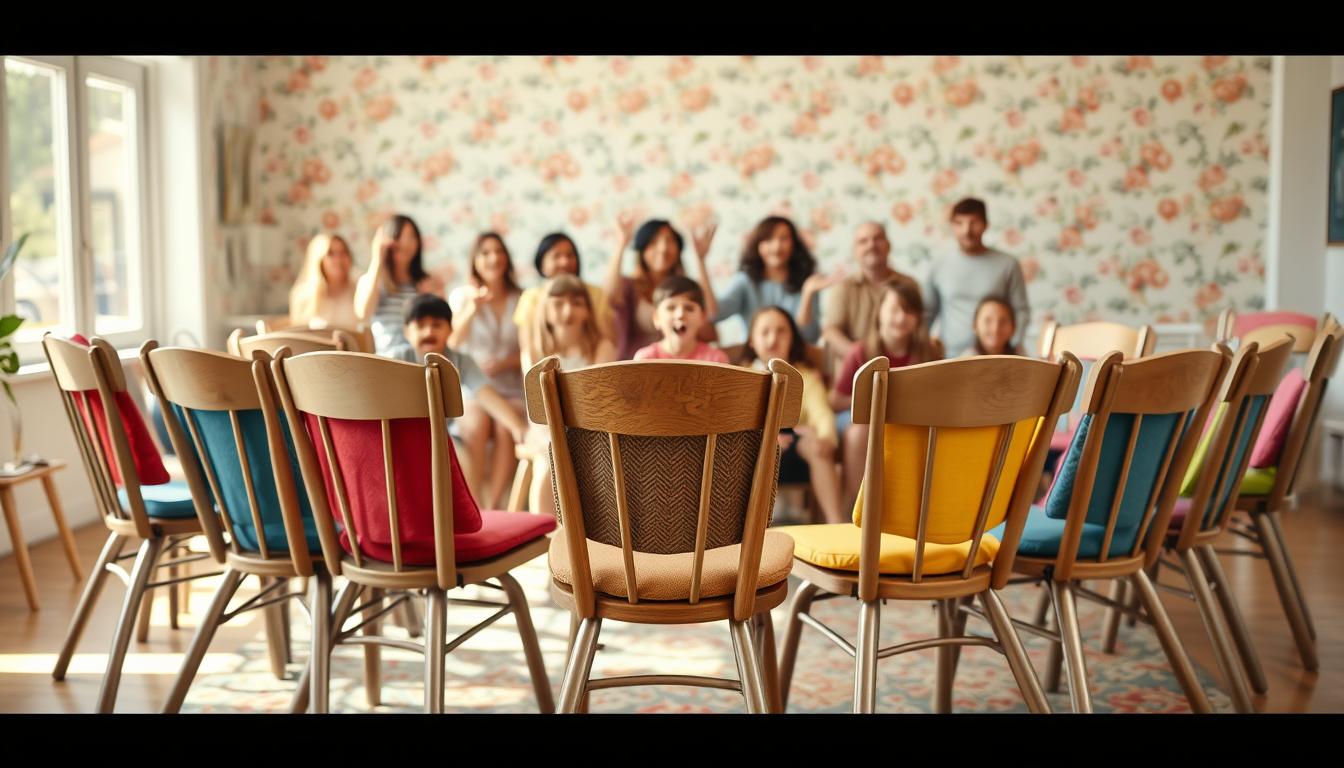Musical Chair Games: Lively Fun for Any Gathering
Picture this: A backyard birthday party in Texas. Kids giggle as they circle seven chairs while Beyoncé blasts from a speaker. The music cuts – six children scramble for seats, one pretending to dramatically faint on the grass. Within minutes, grandparents join the chaos, proving some joys truly are ageless.
This scene captures why chair-based rhythm activities remain beloved nationwide. They turn ordinary moments into shared adventures where anyone can shine. No fancy equipment needed – just chairs, music, and willingness to embrace playful competition.
What makes these experiences endure? They masterfully blend suspense and silliness. Players never know when the beat will stop, creating electric anticipation. Laughter erupts as friends playfully jostle for spots, transforming strangers into teammates.
Modern hosts love how these activities adapt to any group size or age mix. School carnivals, corporate retreats, or family reunions – the format stays fresh. It’s social glue that connects generations through universal language: joy.
Key Takeaways
- Timeless group activities create instant connections across age groups
- Simple setups yield high-energy participation and laughter
- Music-driven games build anticipation and friendly rivalry
- Adaptable for events from kids’ parties to adult team-building
- Encourage movement and social interaction simultaneously
- Require minimal resources for maximum entertainment impact
Introduction to Musical Chair Games

What do Victorian parlors and modern classrooms share? A laughter-filled tradition where chairs become portals to playful connection. This classic activity traces its roots to 19th-century Europe, evolving from formal parlor games into the energetic staple we know today.
From Parlors to Playgrounds
Early versions involved stately walks around furniture to live piano music. By the 1920s, schools adopted it as a tool for teaching rhythm and spatial awareness. “It wasn’t just fun—it trained coordination,” notes historian Margaret Owens. The game’s simplicity allowed endless reinvention while keeping its core thrill intact.
The Secret to Lasting Appeal
Why does this format still spark joy? Three magic ingredients: unpredictability, physicality, and shared vulnerability. When the beat stops, CEOs and kindergartners alike become equal players. It’s democracy in action—one chair short of a full set.
Event planners praise its chameleon-like adaptability. Swap pop hits for jazz standards at senior centers. Use office swivel chairs for corporate icebreakers. The rules stay universal, but the context shapes new memories every time.
Understanding the Rules of Musical Chair Games

Ever wonder why this activity stays exciting through generations? The answer lies in its straightforward yet thrilling structure. Clear guidelines create fair play while leaving room for laughter-filled chaos.
How the Game Works
Start by arranging seats in a circle—always one fewer than participants. When tunes play, everyone walks or dances around the setup. The magic happens when the soundtrack pauses unexpectedly. That’s the scramble signal!
Eliminations occur each round as players race to claim seats. Remove one chair after every pause, keeping the “one less” rule active. Last person seated wins—simple enough for preschoolers but challenging enough for adults.
Key Points Everyone Should Know
Three non-negotiables ensure smooth gameplay:
| Rule | Purpose | Tip |
|---|---|---|
| Music controls pace | Creates suspense | Use wireless speaker |
| No seat reservations | Encourages fairness | Mark chair backs |
| Safe movements only | Prevents injuries | Clear floor space |
Groups often add creative twists—like crab-walking instead of running—without breaking core mechanics. “The best versions keep hearts racing and smiles wide,” says PE teacher Marco Rodriguez. Always clarify house rules before starting to avoid confusion.
Setup Essentials for Musical Chair Games

Great experiences begin with smart preparation. Whether hosting a family reunion or office retreat, nailing the setup transforms ordinary gatherings into unforgettable moments. Let’s break down the elements that turn basic equipment into laughter factories.
Arranging Chairs in a Circle
Start by placing seats in a tight ring, backs facing inward. This classic formation keeps everyone visible and creates equal access. For groups larger than 10, try two concentric circles or back-to-back rows. Always maintain three feet between seats—enough space for playful dashes without collisions.
Key considerations for different events:
- Kids’ parties: Use lightweight plastic seats
- Corporate events: Opt for wheeled office chairs (locked brakes!)
- Outdoor gatherings: Secure foldables with sandbags
Choosing the Perfect Music Playlist
Soundtrack selection makes or breaks the energy. Aim for tracks with clear beat drops and varying tempos—think Bruno Mars’ “Uptown Funk” followed by Taylor Swift’s “Shake It Off.” Keep songs under three minutes to maintain momentum. Pro tip: Alternate genres to surprise players and test reflexes.
Event planner Jessica Wu advises: “Test your speaker setup beforehand. Nothing kills vibes like audio lag during the big pause.” Always have a backup device ready, and position speakers at waist height for even sound distribution.
Step-by-Step Guide to Playing Musical Chair Games
Ready to turn any space into a laughter zone? Follow this foolproof method for organizing crowd-pleasing rhythm activities. The secret lies in balancing structure with spontaneity.
Starting the Game
Begin with chairs arranged in a tight circle. Always use one fewer seat than players—this creates immediate excitement. Gather everyone around and demonstrate the walking path. Clarify three golden rules:
- Keep hands off seats until the music stops
- Move clockwise during play
- Celebrate eliminated friends with high-fives
Event coordinator Tara Simmons suggests: “Use a phone timer for unpredictable pauses. Start with 30-second intervals, then vary the timing.” This builds suspense and keeps participants on their toes.
Elimination and Chair Removal Process
When the beat cuts out, watch the scramble unfold. Anyone left standing exits the game with cheers from the group. Swiftly remove one seat before restarting—this maintains the “one less” rule. For tiebreakers, try dance-offs or trivia questions instead of physical tussles.
Pro tip: Keep eliminated players involved by making them backup DJs or cheer captains. As rounds progress, the circle shrinks and energy peaks. The final face-off between two competitors often becomes legendary—ensure dramatic pauses before the last music stop!
Musical Chair Games: A How-To Approach

Want to spark instant connections at your next event? Start with clear instructions that welcome all skill levels. Begin by demonstrating the walking path around the seats, using exaggerated gestures to break the ice. For first-time players, try non-verbal cues like clapping rhythms to signal when to start moving.
Keep energy high between rounds with quick transitions. Eliminated participants become cheerleaders or DJ assistants, clapping along to the beat. Event coordinator Lisa Chen notes: “The secret is making everyone feel essential—even those out of the game.” Use playful challenges like air guitar contests during chair removal pauses.
Adapt your approach based on group dynamics:
- For mixed ages: Pair younger and older players as “buddy teams”
- In competitive groups: Introduce collaborative scoring systems
- With mobility limitations: Allow seated participants to control music stops
Encourage sportsmanship through creative penalties. Anyone caught pouting gets to lead the next round’s dance moves. Pro tip: Use themed playlists (decade-specific hits or movie soundtracks) to trigger nostalgic bonding moments. This transforms simple seat scrambles into shared storytelling experiences.
Team-building coaches love how these activities reveal leadership styles. Watch who strategizes quietly versus those rallying allies mid-game. The best hosts know when to step back—let the laughter and friendly rivalries write their own unforgettable script.
Key Benefits of Playing Musical Chair Games
What transforms a simple group activity into a powerhouse of personal growth? These rhythm-based challenges sharpen minds and bodies while forging unexpected bonds. Participants gain more than laughs—they develop tools for success in classrooms, boardrooms, and beyond.
Enhancing Team-Building Skills
This lively exercise turns strangers into allies through shared challenges. Players quickly learn to read body language and form strategic alliances. “The best teams use non-verbal cues to coordinate movements,” says team-building coach Elena Torres. Trust-building happens naturally as groups navigate the unpredictable rhythm together.
| Skill Area | Physical Benefit | Social Benefit |
|---|---|---|
| Agility | Improved reflexes | Shared laughter |
| Listening | Better coordination | Enhanced empathy |
| Adaptability | Faster response time | Conflict resolution |
Improving Quick Thinking and Agility
When beats suddenly stop, brains and bodies kick into high gear. Studies show these moments activate decision-making regions in the brain. Players develop spatial awareness as they calculate distances mid-stride. Varying music tempos create new challenges each round.
The activity’s physical demands boost coordination without feeling like exercise. Regular participants often show improved reaction times in daily tasks. It’s learning disguised as play—a winning formula for all ages.
Variations of Musical Chair Games

Who says traditions can’t get a modern makeover? These innovative takes keep the core excitement while adding new layers of challenge. From teamwork-focused versions to sensory surprises, discover five ways to refresh your next gathering.
Cooperative Challenges
Flip the script with reverse rules that prioritize inclusion. Instead of removing seats, add extra participants each round. Players work together to squeeze onto available spots, creating hilarious group poses. This variation builds camaraderie as teams strategize seating arrangements.
Creative Alternatives
Try statue-style play where freezing replaces chair hunting. When music stops, participants strike dramatic poses. Anyone wobbling or laughing gets eliminated. For memory challenges, use color-coded seats and call out hues during pauses. Players must find matching chairs within three seconds.
Obstacle courses take the action to new heights. Set up hoops to jump through or cones to navigate between chair laps. Partner versions require duos to link arms while moving, then share seats during eliminations. “These twists reveal hidden talents,” notes recreation specialist Amy Tanaka. Groups often invent hybrid rules combining multiple variations.
Why stick to basics when you can:
- Assign point values to different chair colors
- Use balance boards instead of traditional seats
- Incorporate trivia questions during elimination rounds
These adaptations maintain the heart-pounding thrill while sparking fresh laughter. Whether you’re hosting toddlers or executives, there’s always room for reinvention in rhythm-based fun.
Creative Twists and Unique Game Modifications
Ever seen a disco ball at a birthday bash? That’s the energy you create when reinventing classic activities. These clever upgrades turn predictable fun into unforgettable moments that spark new inside jokes and bonding opportunities.
Soundtrack Strategies That Set the Mood
The right beats transform ordinary rounds into time-travel adventures. For family reunions, mix Elvis with Billie Eilish. Corporate teams might thrive on 90s hip-hop or movie theme songs. Secret weapon: Include a slow ballad occasionally—watching players scramble to sudden silence never gets old.
Try these music pairings:
- 80s night: “Livin’ on a Prayer” meets neon glow sticks
- Beach party: Surf rock with inflatable palm trees
- Kids’ events: Animated film scores and light-up sneakers
Prop Power-Ups and Playful Consequences
Up the ante with physical challenges that test balance and creativity. Participants might:
- Wear oversized novelty glasses during rounds
- Carry ping-pong balls on spoons
- Balance pool noodles on their shoulders
Eliminated players become part of the entertainment. Create a “dare jar” filled with silly tasks like:
- Reciting tongue twisters backward
- Doing celebrity impressions
- Leading a 30-second conga line
Seasonal twists keep the game fresh year-round. Think pumpkin-shaped seats for Halloween or jingle bell anklets during holiday parties. The best modifications honor tradition while inviting groups to make the experience uniquely theirs.
Musical Chair Games for Different Age Groups
These timeless activities work for all generations when tailored appropriately. Whether hosting toddlers or executives, small tweaks ensure everyone stays engaged and safe. Let’s explore how to customize the experience across age brackets.
Fun for Kids and Preschoolers
Little ones thrive with simplified rules and colorful setups. Swap chairs for soft foam mats to prevent bumps during enthusiastic dashes. Use 30-second music clips from favorite cartoons to match short attention spans.
| Age Group | Seating | Music Style | Round Length |
|---|---|---|---|
| 2-4 years | Floor cushions | Nursery rhymes | 20 seconds |
| 5-7 years | Plastic stools | Disney songs | 45 seconds |
| 8-12 years | Folding chairs | Pop hits | 90 seconds |
Preschool teacher Ana Martinez suggests: “Add learning elements by having children identify colors on seats before sitting.” Always end with group high-fives to keep the focus on participation over competition.
Adapting the Game for Adults
Grown-ups enjoy nostalgic twists with strategic challenges. Replace elimination with team scoring systems—groups earn points for creative seat-sharing solutions. Use throwback playlists from college years to spark laughter and camaraderie.
Corporate trainer David Kwon shares: “We integrate problem-solving tasks during music pauses. Teams might brainstorm marketing slogans while circling chairs.” Office versions often use rolling chairs for added mobility, with clear safety guidelines.
| Feature | Kids’ Version | Adult Version |
|---|---|---|
| Music | Cartoon themes | Decade-themed mixes |
| Movement | Animal walks | Speed-walking challenges |
| Winning | Group stickers | Charity donations |
Enhancing Quick Thinking and Competitive Spirit
Life moves fast—so do the lessons learned circling those seats. When beats suddenly halt, brains shift into high gear. Players make 3 critical assessments in under a second: available spots, competitors’ positions, and safest path forward. Neuroscientists call this “rapid pattern recognition”—the same skill used in emergency response training.
Seasoned participants often develop clever tactics. Some hover near multiple seats, while others track the music’s rhythm to predict pauses. “It’s like chess at warp speed,” notes child psychologist Dr. Rachel Kim. These split-second choices build mental flexibility that helps in school exams and job interviews alike.
Healthy rivalry thrives when framed positively. Try these sportsmanship boosters:
- Award creativity points for dramatic seat dives
- Let eliminated players control music pauses
- End rounds with compliment exchanges
The real win? Learning to adapt quickly without losing joy. As one fifth-grader put it: “You gotta be smart fast, but still laugh when you faceplant!” That balance—between strategy and silliness—prepares us for life’s unpredictable moments.
The Role of Music and Rhythm in the Game
Think about the last time your heart raced to a sudden beat drop—that’s the pulse of rhythm-based fun. Soundtracks don’t just set the mood; they become invisible conductors guiding every laugh and dash. This heartbeat of the experience turns ordinary moments into lessons in timing and teamwork.
Importance of Beat and Tempo
Upbeat tracks make feet fly, while slower rhythms teach body control. Research shows 120-140 BPM works best for mixed-age groups—fast enough to energize, slow enough to prevent collisions. Preschool teachers often use clapping games first to build rhythm awareness before introducing seats.
The magic happens when sound cuts out unexpectedly. Brains and bodies sync up, creating split-second decisions that sharpen listening skills. “It’s like freeze tag with a metronome,” says music therapist Gina Rivera. Kids unknowingly develop pattern recognition that helps with math and reading.
Try these tempo tips:
- Use marching songs for structured movement practice
- Mix in instrumental tracks to reduce lyrical distractions
- Let players suggest songs to boost engagement
Whether it’s disco classics or drum circles, the right soundtrack transforms empty seats into stages for growth. That shared groove? It’s where memories—and life skills—get made.
FAQ
How many seats should I use for a group of 10 players?
Can adults enjoy this activity as much as kids?
What happens if two people sit in the same spot?
How do I adapt this for preschoolers?
Can this activity teach teamwork?
What’s the best way to pick music?
Are there non-competitive versions?
How do I prevent injuries during play?

Sharon Molly is a content creator in lifestyle, fashion, and travel, delivering style-savvy advice and destination insights to inspire confident living. With a background in digital media, she combines aesthetics with practical guidance for modern women on the go.




